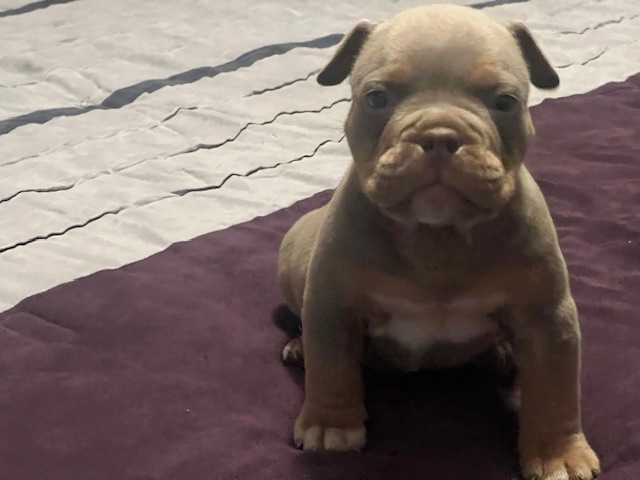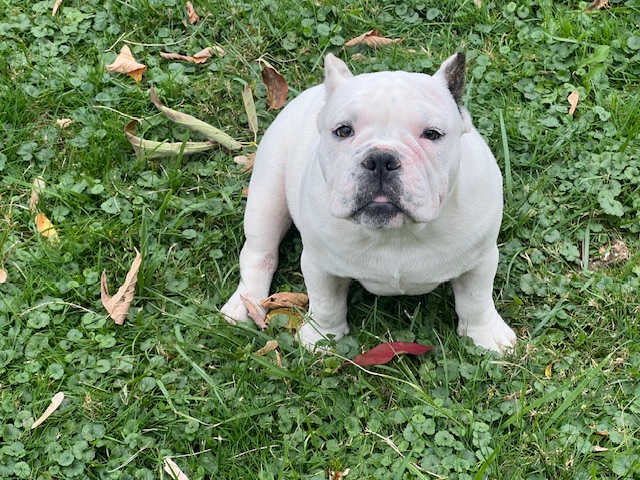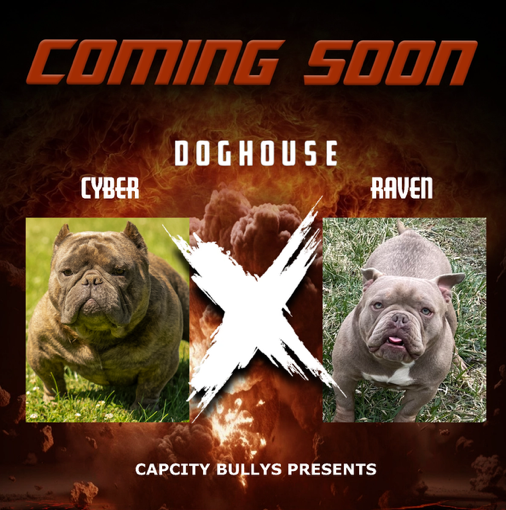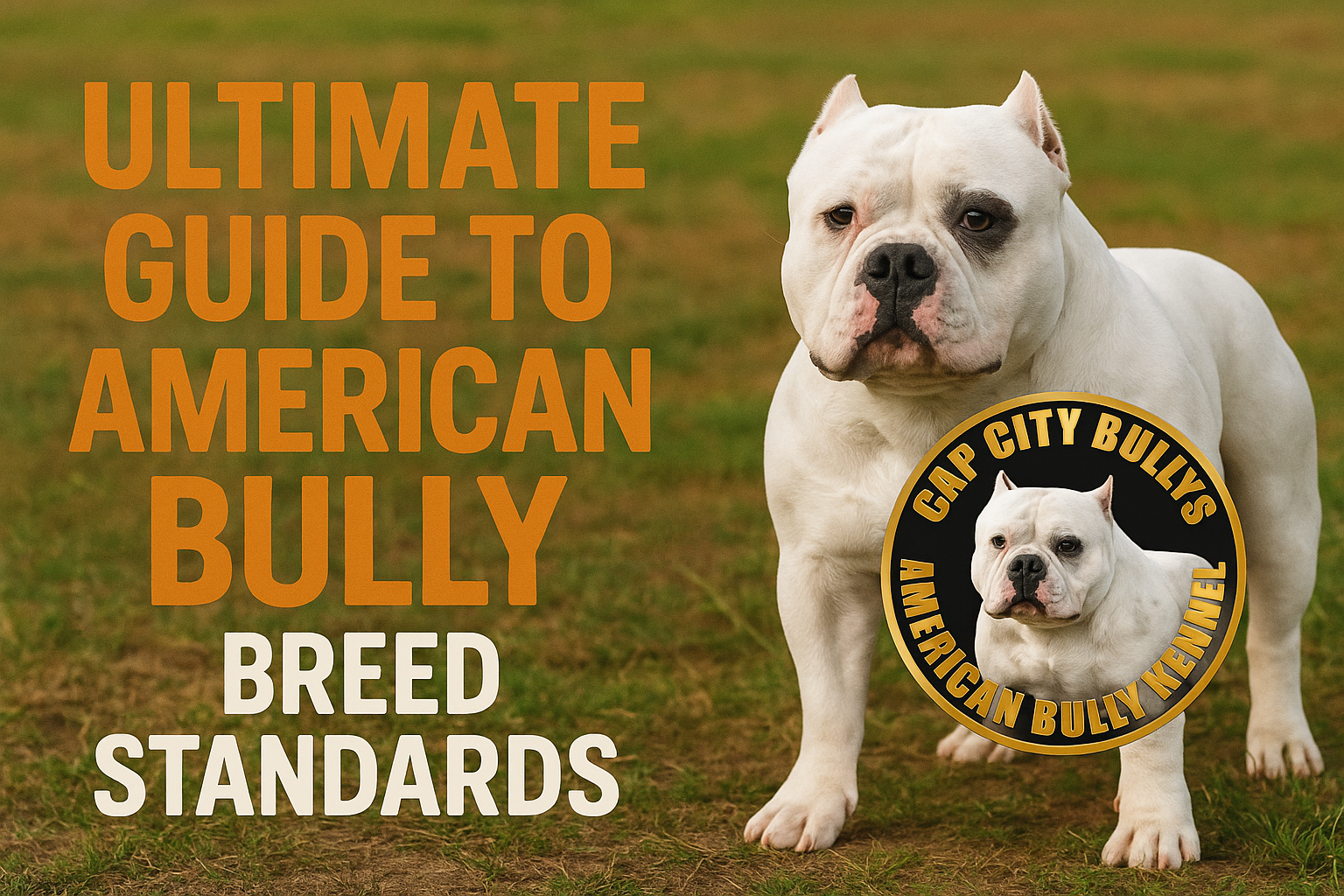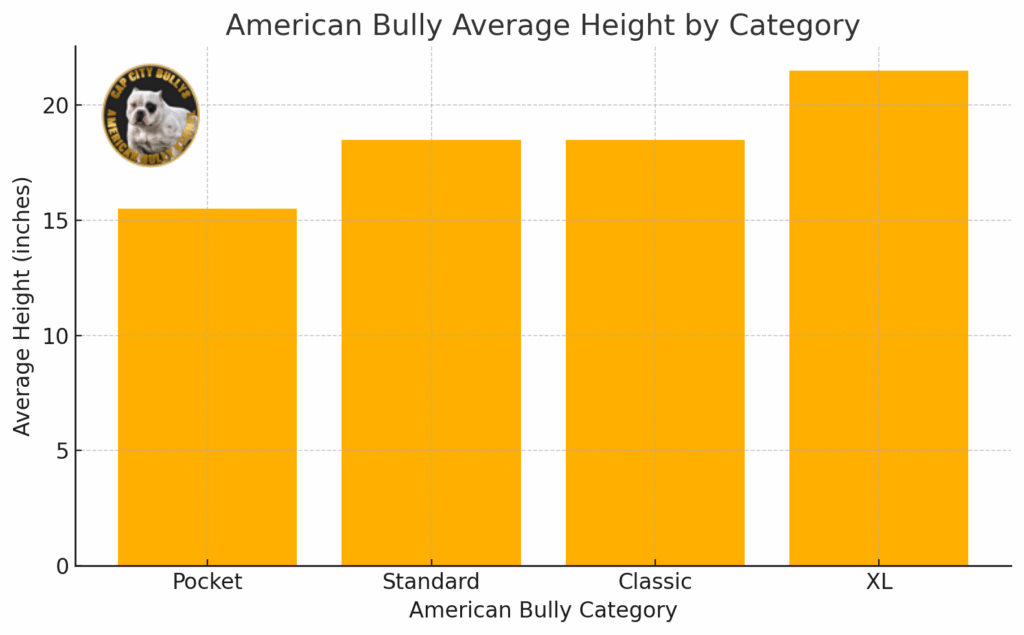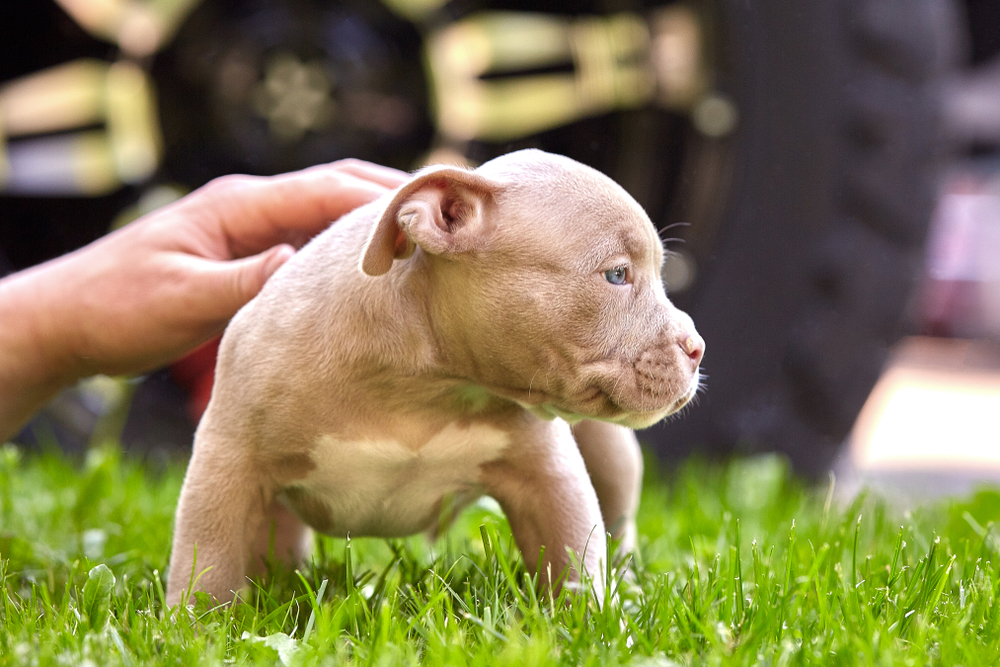Cap City Bullys is Pennsylvania’s premier American Bully breeder, serving families nationwide and worldwide from our Erie, PA facility. With over 15 years of experience, we specialize in producing champion-line, show-quality American Bully puppies noted for their muscular conformation, solid health, and even temperaments. Whether you’re new to the breed or a seasoned Bully enthusiast, these top 10 expert answers will help you understand everything from breed origins to training tips.
1. What Is an American Bully and Where Did This Breed Come From?
The American Bully is a modern breed developed in the United States beginning in the 1980s and 1990s. Breeders sought to combine the best traits of the American Pit Bull Terrier (APBT) and American Staffordshire Terrier (AmStaff) with the bulk and low-slung stature of Bulldog breeds. The goal was a balanced companion dog—muscular and confident, yet gentle and sociable enough for families. Today’s American Bully lines often trace back to renowned bloodlines such as Bape, Bullsace, and Devilspit.
Unlike the APBT, which has a history in working and sporting roles, the American Bully was specifically bred for temperament first—emphasizing stable, friendly personalities. Through careful selection and genetic testing, reputable kennels like Cap City Bullys ensure each litter possesses strong health and predictable temperament. Registries such as the American Bully Kennel Club (ABKC) and United Kennel Club (UKC) now maintain official breed standards focusing on a blocky head, wide chest, and a compact, muscular build.
2. What Are the Different American Bully Types and Sizes?
American Bullies come in five main categories recognized by most major registries:
- Micro:
- Height (males): Under 14 inches; (females): Under 14 inches
- The same muscular definition and confident presence as standard bullies.
- Their compact size makes apartment living or small homes a breeze.
- Pocket:
- Height (males): 14 – 17 inches; (females): 14 – 16 inches
- Retains the thick bone and muscle of Standard Bullies but in a smaller package.
- Great for apartment living or smaller homes, without sacrificing the breed’s iconic look.
- Standard:
- Height (males): 17–20 inches; (females): 16–19 inches
- Muscular, well-balanced frame without extreme bulkiness.
- Ideal for families seeking a dog that combines athleticism with moderate size.
- XL (Extreme):
- Height (males): 20–23 inches; (females): 19–22 inches
- Heavily muscled, wide-chested, and often weighing well over 80 pounds.
- Requires experienced handling, ample space, and a high level of exercise.
- Classic:
- Similar height to Standard but with a leaner, less bulky build reminiscent of early Bully lines.
- Suited for owners who want the Bully temperament without the extreme muscle mass.
Choosing the right type depends on factors like living space, family size, and lifestyle. For example, Micro Bullies excel in apartments because they require slightly less room, while XL Bullies need larger yards and stronger handlers to manage their power. Cap City Bullys produces Micro & Pocket types, each backed by champion pedigrees and health-tested lines.
3. Are American Bullies Aggressive? Debunking Common Misconceptions
Well-bred American Bullies are known for their calm, friendly dispositions, not aggression. Their temperament is the result of decades of selective breeding prioritizing stable, family-oriented behavior. Unlike outdated stereotypes that lump all “bully” breeds into a single category, the modern American Bully standard mandates a gentle, sociable nature suitable for children, seniors, and other pets.
Cap City Bullys puppies are raised in a family environment, exposed to children, household pets, and daily household noises from day one. This early socialization minimizes fear-based reactions and teaches them how to interact politely with strangers. While any dog can become aggressive under poor management—lack of socialization, abusive training methods, or neglect—a properly raised American Bully is unlikely to demonstrate unprovoked aggression. Instead, you’ll find a loyal, loving companion eager to please.
Breed-specific legislation (BSL) sometimes targets Bully-type appearances rather than actual behavior, which experts argue is counterproductive. Responsible ownership—defined by proper socialization, training, and veterinary care—remains the most effective way to reduce any risk of aggression.
4. How Much Exercise Do American Bullies Need Each Day?
American Bullies are moderately to highly active dogs that benefit from regular, structured physical activity. A lack of sufficient exercise can lead to boredom, weight gain, and potentially destructive behaviors such as chewing or digging. Here’s a guideline by life stage:
- Puppy (8–6 months):
- Short play sessions (5–10 minutes) several times a day, avoiding long runs or strenuous exercise to protect developing joints.
- Socialization outings—short, positive experiences with new people, pets, and environments.
- Adolescent (6–24 months):
- Two daily sessions of 15–20 minutes each: brisk walks, supervised fetch, and interactive play.
- Introduction to mental enrichment games (puzzle toys, basic scent work).
- Adult (2+ years):
- At least 45–60 minutes of physical exercise daily: mix brisk neighborhood walks, jogging (once fully grown), and structured play (tug, fetch).
- Mental stimulation: five-minute training drills (sit, down, recall) and puzzle feeders.
Cap City Bullys recommends owners provide a balanced exercise routine to promote healthy muscle development and maintain a lean physique. Mental enrichment—such as teaching new tricks or using treat-dispensing toys—helps satisfy a Bully’s intelligence and prevents boredom.
5. How Easy Is It to Train an American Bully?
Most American Bullies are highly intelligent and eager to please, making them relatively straightforward to train—if you use consistent, reward-based methods. Punishment-based training can backfire, leading to fear or aggression. Instead, positive reinforcement leverages treats, praise, and toys to encourage desired behaviors.
Key principles of effective Bully training:
- Immediate Marking: Use a clicker or a clear verbal marker like “Yes!” the instant your Bully performs the exact behavior you want. This clarifies the connection between action and reward.
- High-Value Rewards: Rotate between small pieces of cooked chicken, cheese, or turkey jerky to keep treats novel and highly motivating. For dogs less food-driven, use a favorite squeaky toy or tug rope.
- Short, Frequent Sessions: Especially for puppies, keep training sessions to 4–5 minutes, 2–3 times daily. Short bursts maintain focus and prevent frustration.
- Gradual Increase in Difficulty: Start in a quiet room for basic commands (sit, down, stay). Once those are solid, introduce mild distractions—family members walking by, other pets nearby.
Common training challenges like leash pulling can be addressed with a stop-and-go method: stop walking when the leash becomes tight; only resume (and reward) once the leash relaxes. If your Bully jumps during greetings, calmly turn away until all four paws are on the floor, then reward the calm behavior. Cap City Bullys puppies come with early obedience tips and lifetime training support to help you every step of the way.
6. What Are the Most Common Health Issues in American Bullies?
American Bullies, like all purebred dogs, have some genetic health predispositions. Responsible breeders such as Cap City Bullys screen parents for joint issues, heart conditions, and eye diseases to minimize these risks. Still, owners should remain vigilant for the following:
- Hip Dysplasia & Elbow Dysplasia: Abnormal joint development leading to arthritis. Regular vet visits, controlled exercise during puppyhood, and feeding a balanced, joint-supporting diet can mitigate risks.
- Cardiac Issues: Conditions like aortic stenosis or mitral valve disease. Reputable breeders provide cardiac clearances (via ultrasounds) for breeding dogs. Periodic heart checks are recommended.
- Eye Problems: Progressive retinal atrophy (PRA) and cataracts appear in some lines. Annual ophthalmologist exams catch issues early.
- Skin Allergies & Mange: Bullies often suffer from environmental or food sensitivities leading to itching, redness, or demodectic mange. Regular grooming, balanced nutrition, and prompt veterinary care help manage these conditions.
- Hypothyroidism: Low thyroid function can cause weight gain, lethargy, and coat changes. A simple blood test during routine checkups detects thyroid disorders, which are manageable with daily medication.
To keep your Bully in peak condition, follow a veterinary-recommended vaccination schedule, maintain parasite prevention year-round, brush teeth two to three times weekly, and schedule biannual wellness exams. Cap City Bullys’ Puppy Health Guarantee outlines our commitment to producing healthy, genetically sound puppies.
7. What Is the Typical Lifespan of an American Bully?
On average, American Bullies live 10–12 years, though many who receive excellent nutrition, consistent exercise, and regular veterinary care can surpass 12 years. Smaller types such as Pocket Bullies sometimes live a bit longer (12–14 years) due to lighter joint stress, while larger XL Bullies—which weigh more—often average closer to 10 years.
Factors Influencing Longevity:
- Genetics & Breeding Quality: Puppies from health-screened parents generally enjoy longer lifespans.
- Nutrition & Weight Management: A balanced, high-protein diet designed for muscular breeds promotes lean muscle mass and helps prevent obesity. Overweight Bullies risk hip dysplasia, heart strain, and diabetes.
- Regular Exercise & Mental Stimulation: Daily walks, play sessions, and puzzle toys keep a Bully mentally sharp, physically fit, and emotionally balanced.
- Preventive Care: Routine vet visits, dental cleanings, and parasite control detect and prevent health problems before they become severe. Cap City Bullys emphasizes preventive veterinary checks and provides detailed puppy medical records for every buyer.
8. Are American Bullies Good Family Pets?
American Bullies—when bred and socialized properly—excel as family companions. They exhibit remarkable loyalty, patience with children, and adaptability to various home environments: apartments, suburban homes, and rural properties alike.
Why Bullies Make Great Family Dogs
- Gentle Temperament: Breeders like Cap City Bullys focus on stable, friendly lines that remain calm around young children, seniors, and other pets. Early exposure to families helps ensure puppies learn appropriate behaviors.
- Protective Instincts: While not aggressive by nature, Bullies often develop strong protective bonds with their families, acting as effective watchdogs.
- Playful & Affectionate: They enjoy interactive play—fetch, tug-of-war—and relish cuddles on the couch. Their eagerness to please makes them ideal partners for family activities.
- Adaptability: Whether your household is high-energy or laid-back, Bullies adjust. They’ll match a jog around the block with you, then nap contentedly at your feet.
Considerations for Families
- Exercise Commitments: All Bullies need daily exercise—at least 45 minutes for adults and shorter, frequent playtimes for puppies. A bored Bully may resort to chewing or digging.
- Training & Socialization: Early obedience training and socialization are essential. Cap City Bullys workshops and resources guide families through positive reinforcement methods to instill good manners.
- Space & Safety: While Pocket Bullies can thrive in apartments, Standard and XL Bullies benefit from secure yards. Ensure fences are sturdy and tall enough to contain a muscular dog.
With proper responsibilities—training, exercise, and supervision—American Bullies become loyal, loving family members capable of fitting into diverse lifestyles.
9. How Much Does an American Bully Cost, and What’s Included with Purchase?
Price Ranges
Factors affecting price include pedigree, coat color (rare colors command premiums), health clearances, and breeder reputation. Cap City Bullys, as a trusted Pennsylvania breeder, offers prices reflecting our 15+ years of expertise, champion pedigrees, and rigorous health testing.
What You Get When You Buy from Cap City Bullys
- Health Guarantee & Genetic Screens:
- Written health contract covering hip dysplasia, heart conditions, and eye issues for the first two years.
- All parents cleared via OFA, PennHIP, and CERF certifications.
- Initial Medical Care:
- Up-to-date puppy vaccinations (distemper, parvo, etc.).
- Deworming schedule.
- Lifetime Breeder Support:
- Ongoing guidance on training, nutrition, grooming, and health issues.
- Access to our proprietary training e-book and blog resources.
- Nationwide & Worldwide Delivery:
- Safe, temperature-controlled transport to your door—domestic or international.
- Real-time updates on travel status.
Cap City Bullys’ transparent pricing and comprehensive support ensure you know exactly what to expect when you invest in a healthy American Bully companion.
10. How Do I Choose the Right American Bully Puppy for My Family?
Selecting the perfect puppy involves multiple considerations—size, temperament, health, and lifestyle compatibility. Cap City Bullys helps guide families through this process with personalized support.
Key Factors to Evaluate
- Size & Space Requirements:
- Micro Bully: The smallest in the Bully family, suited for urban living. Requires moderate exercise.
- Pocket Bully: Ideally suited for apartments or smaller living spaces. Requires moderate exercise.
- Standard Bully: Fits most suburban homes with yards. Balanced exercise needs.
- XL Bully: Demands a large yard and strong handler; high exercise requirements.
- Classic Bully: A balance of moderate size and a more streamlined build.
- Family Composition & Lifestyle:
- Homes with Young Children: Puppies from calm, well-socialized lines known for gentle dispositions. Puppies are raised around children from day one at Cap City Bullys.
- Active Singles/Couples: Consider older juveniles or adults already housetrained and basic-obedience tested.
- Show vs. Pet: Show-quality pups come from champion-lines, with pedigrees from families like Bape × Devilspit; they carry breeding rights. Pet-only puppies reduce initial cost if you don’t plan to breed.
- Temperament & Early Testing:
- Cap City Bullys employs Holistic Early Neurological Stimulation (HENS) and temperament assessments at 4–5 weeks, evaluating prey drive, sensitivity, and social interest.
- Puppies that confidently approach handlers, show curiosity, and remain calm under mild stress typically excel in family settings.
- Health Clearances & Guarantees:
- Ensure parents have passed hip/elbow X-rays, cardiac ultrasounds, and eye exams.
- Cap City Bullys provides all puppy buyers with health clearances and a detailed record of early veterinary visits.
- Breeder Reputation & Support:
- Confirm the kennel offers lifetime support for training and health guidance.
- Visit Cap City Bullys in Erie, PA, or schedule a video call for virtual tours and Q&A sessions. We encourage transparency—see our adults and past litters to gauge consistency in conformation and temperament.
Additional Inbound Cap City Bullys Resources
- E-Book: The American Bully
- Download our definitive breed guide covering history, bloodlines, and care strategies: E-Book: The American Bully.
- Puppies for Sale
- View current litters, reserve your puppy, and explore pricing: Puppies for Sale.
- Cap City Bullys Blog
- Explore deep-dive articles on nutrition, training, grooming, and breed care: Cap City Bullys Blog.
- Puppy Health Guarantee
- Learn about our health protocols, genetic testing procedures, and two-year health coverage: Puppy Health Guarantee.
- Puppy Purchase Contract
- Review buyer responsibilities, breeding rights, and health terms before finalizing: Puppy Purchase Contract.
Outbound References
- American Bully FAQ: Answers to Your Burning Questions
For a comprehensive FAQ covering sizes, temperaments, health concerns, and socialization tips specific to American Bullies, see: American Bully FAQ: Answers to Your Burning Questions American Bully Lover - American Bully: Your Complete Guide
For an in-depth overview of American Bully breed characteristics, care requirements, and frequently asked questions, refer to: American Bully: Your Complete Guide
Final Thoughts
These Top 10 American Bully FAQs offer a foundation of expert knowledge—covering breed origins, size variations, temperament facts, exercise needs, training methods, health considerations, lifespan, family compatibility, cost expectations, and puppy selection. As a Pennsylvania breeder with nationwide services, Cap City Bullys is committed to producing champion-line, healthy, and well-socialized American Bullies.
Whether you reside in Erie, PA, or across the country (or globe), you can trust Cap City Bullys to deliver a lifetime companion with top-tier genetics, comprehensive health guarantees, and ongoing breeder support. Explore our inbound resources, learn from AKC and Wikipedia on positive reinforcement and clicker training, and embark on a rewarding journey with your perfect American Bully.
Welcome to Cap City Bullys — The #1 Choice for Show-Quality American Bully Puppies
At Cap City Bullys, we’ve spent 15+ years perfecting the art of breeding purebred, registered American Bully puppies that stand out for their muscular conformation, rock-solid health, and calm, even temperaments. Located in Erie, Pennsylvania, our family-run kennel serves bully enthusiasts from New York to California—and ships champion-line puppies safely across the globe.




